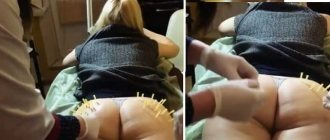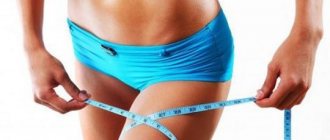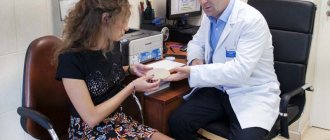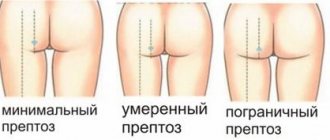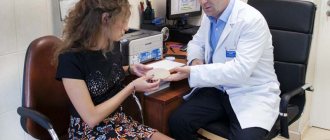The harmonious size and shape of the buttocks is the dream of every woman. Lack of volume, unsatisfactory contours of the gluteal muscles, sagging tissues - all this causes complexes.
To look good in tight clothes and a swimsuit, you need a firm and toned butt. Women are not always able to achieve the desired result with the help of sports. In this case, the most effective solution to the problem is gluteoplasty - surgery to enlarge the buttocks. Plastic surgery of this area helps to achieve lasting aesthetic results and has a positive effect on self-esteem and self-awareness.
In this material we will talk about the methods by which surgical correction of the buttocks can be carried out, how the operation and recovery proceed, what contraindications exist for plastic surgery and how much it costs to enlarge the female buttocks.
Methods for increasing hips and buttocks
Use of implants
Buttock augmentation with implants is the most popular correction method. Implants are:
- round
: to give the buttocks a noticeable bulge; - anatomical
(teardrop-shaped): for maximum natural correction of this area; - oval
: like teardrop-shaped, this type of implant follows the contours of the body and provides an organic change in shape.
The sizes of implants are determined individually.
Usually these are endoprostheses with a volume of 140-180 milliliters. Do not trust doctors who claim that the size of the implant does not matter and that you can enlarge your butt even with very voluminous implants. This is wrong. An overly large implant will lead to stretch marks on the skin, deformation of the buttocks and poor aesthetics. In addition, it will begin to sink down. Implants are made of silicone. Its main advantage is the ability to adapt to the anatomical features of the patient’s body. The most popular manufacturing companies are EuroSilicone, Sebbin, Polytech, Silimed. The doctor will recommend endoprostheses to choose from. All major manufacturers provide a lifetime warranty on implants.
The operation is not performed if there is insufficient muscle tissue. If nothing “holds” the implants, they will shift and sag.
Endoprosthetics can be combined with lipofilling, which will be discussed below.
Lipofilling (fat augmentation)
The lipofilling method is very popular among patients with fat deposits in the abdomen, sides, thighs, and arms.
Fat tissue is collected from problem areas, followed by cleansing and injection into the buttock area. With the help of lipomodeling, you can correct a local lack of volume (for example, dimples on the butt) or significantly change the shape of the buttocks. The advantage of the procedure is the ability to reduce the volume of the problem area and increase the buttocks with the help of the harvested fat - you get a “two in one” effect. The advantage is the natural appearance of the butt after surgery, as well as the durability of the result. The implanted fat survives at least 70% and remains with you forever. It is only important to exclude sudden weight loss. Lipomodeling can also be performed even if you have implants installed.
The downside is that the operation is not suitable for thin women who have nowhere to take fat cells from. It is also not always possible to achieve the desired result in one operation. As a rule, 2-3 lipofilling procedures are needed.
Muscle tightening
Sometimes enlargement of the hips and buttocks is not required, all that is needed is a tightening of the existing forms, and muscle lifting is performed. This is a very extensive intervention that requires long-term rehabilitation. Typically, the procedure is indicated for older patients with muscle atrophy. It is also recommended for young women with insufficient muscle mass who are not indicated for endoprosthetics and lipofilling. The advantage of the operation is a significant change in the shape of the buttocks. The disadvantage is a long recovery.
Other enlargement methods
You can enlarge your gluteal muscles by injecting fillers based on hyaluronic acid.
The disadvantage of this method is the high cost and fragility of the result - a maximum of 5 years. The procedure also requires general anesthesia. You can tighten your buttocks by installing threads: gold, Aptos, with or without notches. This method will visually tighten the buttocks, but it will not increase the volume. Over time, the effect will fade away, while competently performed gluteoplasty guarantees an aesthetic appearance of the buttocks forever.
The introduction of silicone gels is a dangerous and unpredictable method of buttock augmentation. No modern clinic performs this procedure. The fact is that the gel migrates in the tissues, which leads to deformation of the gluteal region, the appearance of unaesthetic tubercles and pits. Silicone can also cause inflammation, severe pain and even tissue necrosis. On the Internet you can find a lot of disastrous results from the injection of silicone into the buttocks. If for some reason it was nevertheless introduced, surgical removal of the substance is required. And the sooner the better.
Some pseudosurgeons practice subcutaneous implant placement. This is dangerous and will never provide a decent aesthetic result.
Enlargement of the hips and buttocks is also possible with the help of a set of exercises. Finally, there is special shapewear that visually enlarges the area of the gluteal muscles.
Butt lift. What does it represent?
A butt lift is a medical procedure that is aimed at correcting the shape, size, and volume of the buttock area. Most often, representatives of the fair sex deal with this problem, especially after the birth of a child or rapid weight loss. However, buttock lifting is also quite popular among men. Sagging tissues are difficult to tighten with the help of physical exercises, diets, and the use of cosmetics. Especially if ptosis has developed to degree 3-4. Therefore, the most effective method is plastic surgery or lifting with threads and fillers.
How is buttock augmentation surgery performed?
1. Consultation with a doctor
. The plastic surgeon will ask you a series of questions related to your health and your wishes regarding the outcome of the surgery. The doctor may refuse to carry out correction if the patient comes for consultation in a mentally unstable state.
2. Conducting research
and passing the necessary tests:
- blood group and Rh factor;
- blood for infections: hepatitis B, C, syphilis, HIV;
- CBC with leukocyte formula and ESR;
- coagulogram: APTT, fibrinogen, INR, PTI;
- used blood test: glucose, ALT, AST, total protein, creatinine, urea, total and direct bilirubin;
- general urine analysis;
- ECG with interpretation;
- in the presence of somatic pathology - consultation with a therapist and cardiologist.
3. Preparation for surgery
:
- Avoid taking blood thinning medications;
- Avoid drinking alcohol and smoking at least 7 days before surgery;
- start taking medications prescribed by the surgeon;
- eliminate stressful situations, adhere to a normal sleep schedule.
4. Day of surgery
. You must come to the clinic on an empty stomach. This is followed by a conversation with the surgeon and anesthesiologist. The operating doctor applies preoperative markings, and the patient is transferred from the ward to the operating room. The operation itself lasts 1.5-2 hours. During the intervention, the doctor makes an incision in the intergluteal fold. Next, special pockets are created in which the implants are installed. They are usually placed between the gluteus maximus and gluteus medius muscles (the upper third of the butt). It is possible to install an implant in the area of the gluteus maximus muscle. Incisions can also be made in the subgluteal folds, but this may result in the implants being placed too low. At the end of the procedure, the doctor installs drainages to subsequently remove excess fluid. Then internal and external sutures are applied, they are sealed, the patient is removed from anesthesia and moved to the ward.
5. After surgery
. You stay in the clinic until the next morning. The doctor must change your dressing, then he sets a date for your next visit, and you go home.
Using special threads
Using special threads, skin flaps can be tightened. To do this, the material is injected under the skin, capturing soft tissues and ligaments. The threads have special devices on their surface (which grab the fabric and pull it along). The result is the desired effect. The advantages of this method of lifting are as follows. Firstly, no anesthesia is required; the procedure is performed under local anesthesia. Secondly, there are practically no contraindications. Thirdly, the desired result is achieved within 1-2 hours. Among the disadvantages of the method, one can highlight the instability of the resulting effect.
Rehabilitation period
- After surgery, the buttock area will be sore. As prescribed by your doctor, you need to take painkillers and antibiotics. While taking antibiotics, you should not drink alcohol. The pain syndrome dulls after 2-3 days.
- In the first days, it is advisable to observe bed rest. Moreover, for 7 days after the operation you cannot lie on your back or sit on your butt. Only lying on your stomach is allowed. This is an important condition for comfortable recovery and predictable results. During this period, there may be a decrease in tissue sensitivity in the buttock area. This is normal.
- For the first three days you should not shower.
- You wear compression garments for a month to secure the implants.
- Physical activity is prohibited for at least 1 month. You need to return to sports gradually. The first workout should be very easy.
- During the recovery period, you cannot go to the pool, bathhouse, or solarium. You cannot sunbathe or swim in open water.
- If the suture festers, you should immediately see a doctor.
During the rehabilitation period, swelling, bruising, and hematomas may be observed - this is a normal reaction to surgery.
The first results can be assessed 1-2 months after the operation; the final shape of the buttock will be taken 1 year after the intervention.
Please note that for patients with buttock replacement, injections into the gluteal muscle remain forever prohibited. Be sure to inform your doctors about the presence of implants.
Technique of the operation
Today, you can give shape to your buttocks in two ways - using filler injections or your own fat, or implants.
Effective injection methods include lipofilling and correction of the buttocks using a biodegradable gel such as Macroline. This method is used if the volume to be added is relatively small. Using this technique, the pronounced subgluteal fold is filled, which helps reduce the effect of “sagging” of the buttocks. Fat grafting and fillers are also used to sculpt the upper buttocks. The procedure can be repeated an unlimited number of times until the optimal effect is achieved and maintained. The effect lasts, on average, six months to a year.
With gluteoplasty using implants, the result is visible immediately (it can be assessed the very next day after surgery) and lasts for many years. In addition, the need to repeat the procedure disappears. After gluteoplasty and final healing, the scars are almost invisible.
Indications
- congenital asymmetry of the gluteal muscles;
- deformation of the buttocks due to injuries;
- change in shape due to sudden weight loss;
- age-related tissue sagging;
- muscle atrophy;
- individual characteristics;
- lack of results from training;
- dissatisfaction with the appearance of the buttocks.
Gluteoplasty is purely aesthetic in nature. It is not performed for medical reasons, but to improve the shape and volume of the buttocks.
Buttock reduction
Getting rid of “fat traps” in the thighs is not always possible with the help of diets and exercise. An important role is played by a genetic predisposition to the accumulation of fatty deposits on the thighs. To reduce the volume of the buttocks and improve the proportions of the figure, liposuction is used. This operation is minimally traumatic, does not leave noticeable scars and allows you to get rid of excess fat deposits in a short time. Plastic surgeons at the Pirogov Clinic are fluent in the latest liposuction methods. For example, high-precision vibration liposuction allows you to effectively work with cellulite and eliminates the formation of unevenness and bumps on the skin.
Contraindications
- minor age;
- pathologies of the heart, blood vessels, liver, kidneys, thyroid gland;
- autoimmune diseases;
- exacerbation of chronic diseases;
- colds, infectious and viral diseases;
- oncology;
- benign and malignant tumors;
- obesity;
- diabetes;
- period of pregnancy and lactation;
- mental disorders;
- tendency to form keloid scars;
- unsatisfactory results of preoperative studies;
- tissue damage in the gluteal muscle area.
We usually perform buttock augmentation surgery on patients over 25 years of age, when the body is fully developed. In rare cases, surgery can be performed earlier.
Lipofilling of the buttocks
A method of buttock augmentation and shape correction using a transplant of one’s own fat tissue transplanted from other areas (abdomen, thighs). Thus, an additional advantage of the technique is the ability to correct other figure flaws. if they are. Lipofilling of the buttocks allows not only to give the figure the desired fullness and roundness, but also to eliminate the asymmetry of the buttocks and improve the quality of the skin at the cellular level. When transplanted, your own fat cells take root safely and do not cause allergies. Buttock augmentation with lipofilling does not leave noticeable surgical scars on the body. The collection and injection of fat cells is carried out using a special cannula (diameter - 4-5 mm).
Possible complications
If the operation is performed by an experienced doctor in a modern operating room, and if the patient follows all the surgeon’s recommendations, then no complications will arise. If the surgical protocol is violated, low-quality implants are used and the doctor’s instructions are not followed, complications may arise such as:
- displacement of the implant/s;
- development of the inflammatory process;
- seam divergence;
- suppuration;
- deformation of the buttock area;
- implant rupture;
- formation of kelod scars at incision sites;
- the appearance of excess connective tissue.
The result of the operation depends equally on both the doctor and the patient. A responsible approach to choosing a clinic and to your health is a guarantee of lasting aesthetic results.
Cost of gluteoplasty
The procedure for enlarging the gluteal region at the Medial clinic costs 150,000 rubles. This amount includes:
- Consumables;
- anesthesia support;
- the operation itself;
- hospital stay.
The indicated price does not include:
- preoperative tests;
- buttock implants.
Lipofilling of the buttocks costs from 80,000 rubles.
To determine the price of surgery in your case, you need to consult a surgeon. The multidisciplinary medical center has been providing buttock augmentation services since 2002. Our surgeons Anzhelika Vladimirovna Nikolaeva-Fedorova and Levan Leonidovich Valiev perform gluteoplasty. You can make an appointment for a consultation by phone.
Preparation for surgical correction of the buttocks
You should start preparing with a consultation with a plastic surgeon. After conducting an examination, the doctor will listen to the patient’s complaints and wishes, make suggestions on the surgical technique, and report on the method of anesthesia.
Next, you need to undergo preoperative diagnostics. This is a mandatory step for every surgical procedure and allows you to identify health problems that may interfere with surgery.
The list of contraindications to buttock surgery includes:
- malignant processes;
- diabetes;
- heart and vascular diseases;
- bleeding disorders;
- infections of various origins;
- pregnancy, lactation, etc.

